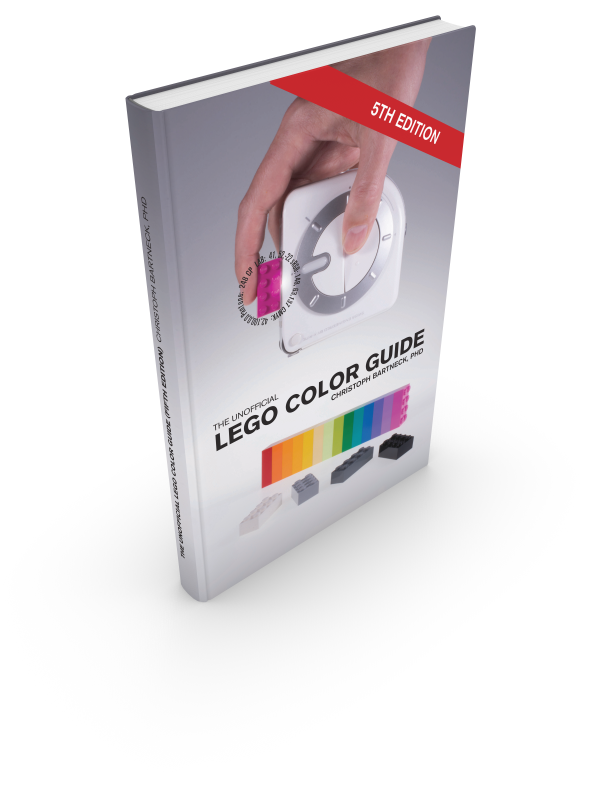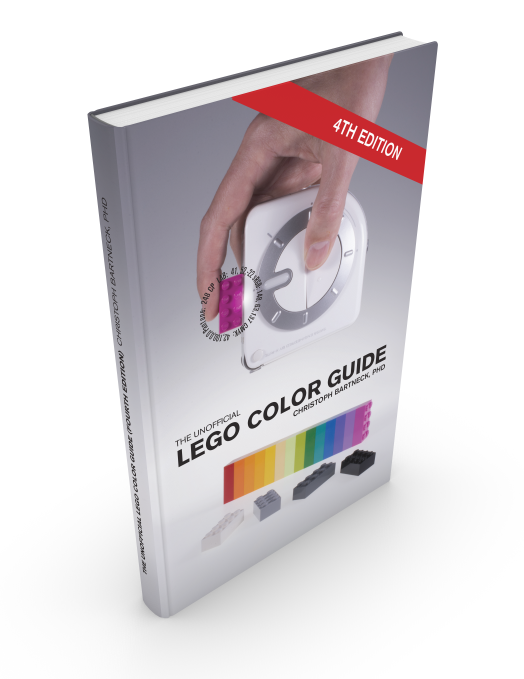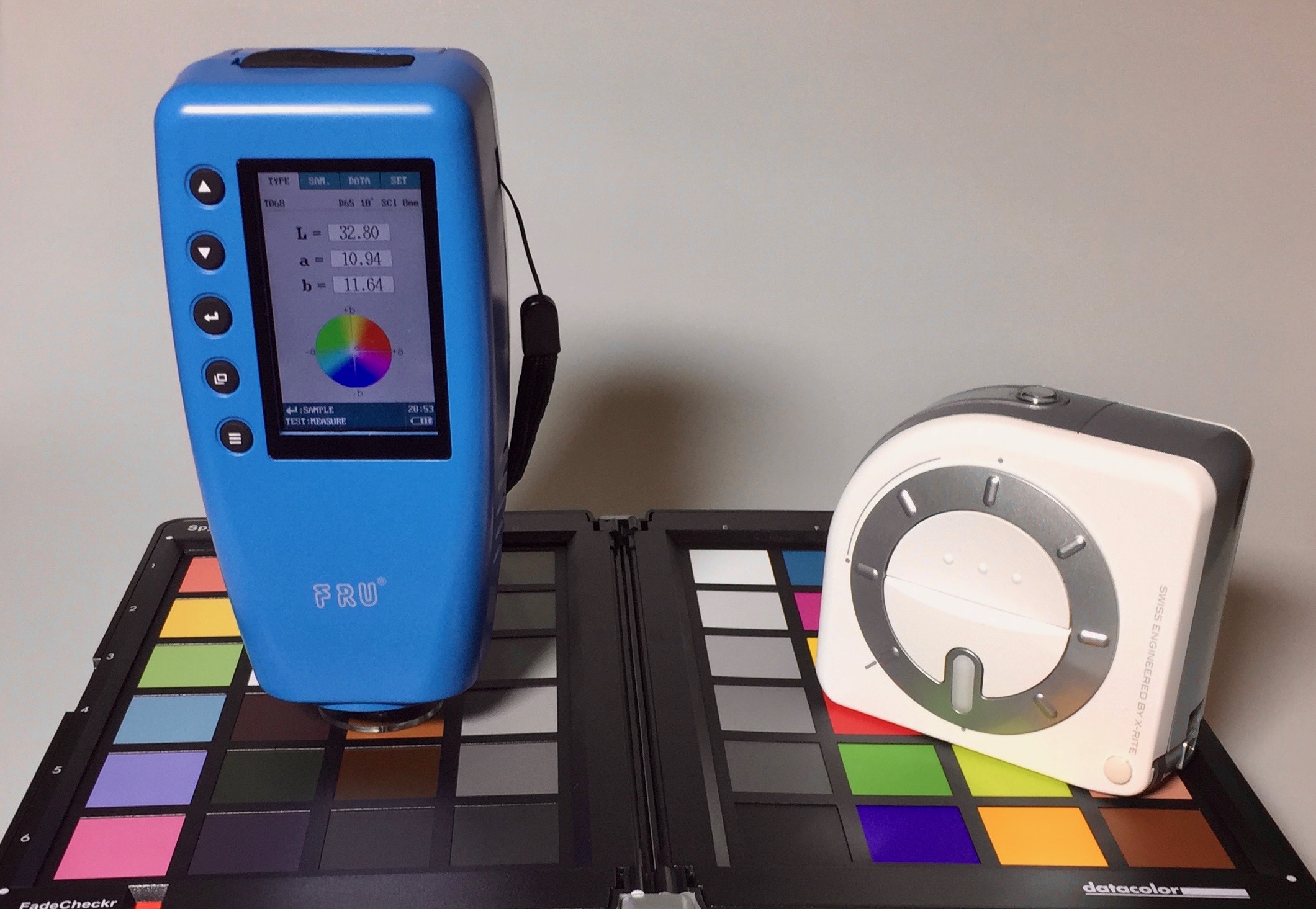The sixth edition of the Unofficial LEGO Color Guide is now available. The book is available as a paperback and hardcover from Amazon.com. An eBook (PDF) is available from Lulu. This revised and extended edition includes several new colors. It also is printed in IngramSpark’s new Ultra Premium Color printing process.
Tag: color
5th Edition of the Unofficial LEGO Color Guide
I am happy to announce that the fifth edition of the The Unofficial LEGO Color Guide is now available. The book is available as a paperback and hardcover from Amazon.com. An eBook (PDF) is available from Lulu.
An important update happened behind the scenes. In the past I exported the color database to Adobe InDesign and then create the catalog from there. This process was complicated, labour intensive and error prone. The database has now been changed to create the catalog pages directly. Unfortunately, not all the design tricks possible with InDesign can be replicated with the database. The visual design was therefore modernised and extended.
New LEGO Color Guide Published
I am proud to announce that the fourth edition of the Unofficial LEGO Color Guide is now available. The printed book is available as a paperback and hardcover from Amazon and other resellers. An eBook (PDF) is available from Lulu. The paper printing process has a limited color space and hence I recommend the PDF if you need to have best possible representation. Head over to Minifigure.org for more details on the book.
Comparison of color measurement accuracy of ColorMunki Design and FRU WR-10QC Colorimeter
Review of the measurement accuracy of the ColorMunki Design and the FRU WR-10.
I am working on a colour project and had purchased the WR10 colorimeter to complement my long serving work horse, the X-Rite Color Munki Design. My ColorMunki is already several years old and I was concerned that its accuracy might have declined. When I measured several hundreds of samples, I noticed that both colorimeters gave me considerably different LAB values.
To determine which device was closer to the truth I measured the 48 defined colours of Datacolor’s SpyderCHECKR 48. I calculated the absolute error both devices made. The results of a paired-sample t-test showed that the ColorMunki is producing significantly less measurement errors on L (t(47)=-9.229, p<0.001), L (t(47)=-4.590, p<0.001) and L (t(47)=-4.871, p<0.001). However, both devices measure colours that are significantly different from the target colour of the SpyderCheckr card on all three measurements. Figure 1 shows the means and standard deviation for all measurement errors.
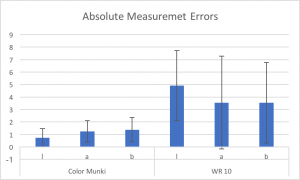
There does seem to be some structure in the errors that WR-10 is producing. Have a look at the heat map (Figure 2). The data for my little experiment is available at the Open Science Framework (DOI: 10.17605/OSF.IO/UWEFD).
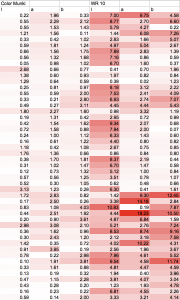
Although both devices show some significant deviation from the original, it is not far off from what can be expected of devices in this price range. The ColorMunki Design produces significantly better results than the FRU’s WR-10QC.
Patch color definitions for Datacolor SpyderCheckr 48
Below you find the Datacolor SpyderCheckr 48 definition of patches in different color spaces, such as LAB, sRBG and AdobeRGB. Datacolor offers a lousy bitmap of the values which are difficult to read and impossible to use in a structured way. So there you go, a table of all the values that this color chart is suppose to represent:
| Lab | sRGB | Adobe RGB | |||||||||
|---|---|---|---|---|---|---|---|---|---|---|---|
| Number | Patch | Name | L | A | B | R | G | B | R | G | B |
| 1 | 1A | Low Sat. Red | 61.35 | 34.81 | 18.38 | 210 | 121 | 117 | 189 | 121 | 117 |
| 2 | 2A | Low Sat. Yellow | 75.5 | 5.84 | 50.42 | 216 | 179 | 90 | 205 | 178 | 96 |
| 3 | 3A | Low Sat. Green | 66.82 | -25.1 | 23.47 | 127 | 175 | 120 | 141 | 174 | 122 |
| 4 | 4A | Low Sat. Cyan | 60.53 | -22.6 | -20.4 | 66 | 157 | 179 | 103 | 156 | 177 |
| 5 | 5A | Low Sat. Blue | 59.66 | -2.03 | -28.46 | 116 | 147 | 194 | 125 | 146 | 191 |
| 6 | 6A | Low Sat. Magenta | 59.15 | 30.83 | -5.72 | 190 | 121 | 154 | 172 | 120 | 151 |
| 7 | 1B | 10% Red Tint | 82.68 | 5.03 | 3.02 | 218 | 203 | 201 | 213 | 202 | 200 |
| 8 | 2B | 10% Green Tint | 82.25 | -2.42 | 3.78 | 203 | 205 | 196 | 202 | 204 | 195 |
| 9 | 3B | 10% Blue Unit | 82.29 | 2.2 | -2.04 | 206 | 203 | 208 | 204 | 201 | 206 |
| 10 | 4B | 90% Red Tone | 24.89 | 4.43 | 0.78 | 66 | 57 | 58 | 66 | 60 | 60 |
| 11 | 5B | 90% Green Tone | 25.16 | -3.88 | 2.13 | 54 | 61 | 56 | 59 | 63 | 59 |
| 12 | 6B | 90% Blue Tone | 26.13 | 2.61 | -5.03 | 63 | 60 | 69 | 65 | 63 | 71 |
| 13 | 1C | Lightest Skin | 85.42 | 9.41 | 14.49 | 237 | 206 | 186 | 225 | 202 | 183 |
| 14 | 2C | Lighter Skin | 74.28 | 9.05 | 27.21 | 211 | 175 | 133 | 200 | 174 | 134 |
| 15 | 3C | Moderate Skin | 64.57 | 12.39 | 37.24 | 193 | 149 | 91 | 180 | 148 | 95 |
| 16 | 4C | Medium Skin | 44.49 | 17.23 | 26.24 | 139 | 93 | 61 | 127 | 93 | 65 |
| 17 | SC | Deep Skin | 25.29 | 7.95 | 8.87 | 74 | 55 | 46 | 71 | 58 | 50 |
| 18 | SC | 95% Gray | 22.67 | 2.11 | -1.1 | 57 | 54 | 56 | 59 | 57 | 59 |
| 19 | 1D | 5% Gray | 92.72 | 1.89 | 2.76 | 241 | 233 | 229 | 238 | 233 | 229 |
| 20 | 2D | 10% gray | 88.85 | 1.59 | 2.27 | 229 | 222 | 220 | 226 | 221 | 219 |
| 21 | 3D | 30% Gray | 73.42 | 0.99 | 1.89 | 182 | 178 | 176 | 180 | 177 | 174 |
| 22 | 4D | 50% Gray | 57.15 | 0.57 | 1.19 | 139 | 136 | 135 | 137 | 135 | 134 |
| 23 | 5D | 70% Gray | 41.57 | 0.24 | 1.45 | 100 | 99 | 97 | 99 | 99 | 98 |
| 24 | 6D | 90% Gray | 25.65 | 1.24 | 0.05 | 63 | 61 | 62 | 65 | 63 | 64 |
| 25 | 1E | Card White | 96.04 | 2.16 | 2.6 | 249 | 242 | 238 | 247 | 242 | 237 |
| 26 | 2E | 20% Gray | 80.44 | 1.17 | 2.05 | 202 | 198 | 195 | 199 | 196 | 193 |
| 27 | 3E | 40% Gray | 65.52 | 0.69 | 1.86 | 161 | 157 | 154 | 158 | 156 | 153 |
| 28 | 4E | 60% Gray | 49.62 | 0.58 | 1.56 | 122 | 118 | 116 | 120 | 118 | 115 |
| 29 | 5E | 80% Gray | 33.55 | 0.35 | 1.4 | 80 | 80 | 78 | 81 | 81 | 79 |
| 30 | 6E | Card Black | 16.91 | 1.43 | -0.81 | 43 | 41 | 43 | 46 | 46 | 47 |
| 31 | 1F | Primary Cyan | 47.12 | -32.5 | -28.75 | 0 | 127 | 159 | 39 | 126 | 157 |
| 32 | 2F | Primary Magenta | 50.49 | 53.45 | -13.55 | 192 | 75 | 145 | 167 | 76 | 141 |
| 33 | 3F | Primary Yellow | 83.61 | 3.36 | 87.02 | 245 | 205 | 0 | 234 | 204 | 37 |
| 34 | 4F | Primary Red | 41.05 | 60.75 | 31.17 | 186 | 26 | 51 | 159 | 32 | 53 |
| 35 | 5F | Primary Green | 54.14 | -40.8 | 34.75 | 57 | 146 | 64 | 94 | 145 | 71 |
| 36 | 6F | Primary Blue | 24.75 | 13.78 | -49.48 | 25 | 55 | 135 | 41 | 58 | 132 |
| 37 | 1G | Primary Orange | 60.94 | 38.21 | 61.31 | 222 | 118 | 32 | 196 | 117 | 44 |
| 38 | 2G | Blueprint | 37.8 | 7.3 | -43.04 | 99 | 86 | 96 | 70 | 89 | 156 |
| 39 | 3G | Pink | 49.81 | 48.5 | 15.76 | 195 | 79 | 95 | 170 | 80 | 94 |
| 40 | 4G | Violet | 28.88 | 19.36 | -24.48 | 83 | 58 | 106 | 78 | 61 | 104 |
| 41 | 5G | Apple Green | 72.45 | -23.6 | 60.47 | 157 | 188 | 54 | 165 | 186 | 69 |
| 42 | 6G | Sunflower | 71.65 | 23.74 | 72.28 | 236 | 158 | 25 | 218 | 157 | 46 |
| 43 | 1H | Aqua | 70.19 | -31.9 | 1.98 | 98 | 187 | 166 | 130 | 186 | 166 |
| 44 | 2H | Lavender | 54.38 | 8.84 | -25.71 | 126 | 125 | 174 | 125 | 124 | 171 |
| 45 | 3H | Evergreen | 42.03 | -15.8 | 22.93 | 82 | 106 | 60 | 90 | 106 | 65 |
| 46 | 4H | Steel Blue | 48.82 | -5.11 | -23.08 | 87 | 120 | 155 | 98 | 119 | 152 |
| 47 | SH | Classic Light Skin | 65.1 | 18.14 | 18.68 | 197 | 145 | 125 | 183 | 144 | 125 |
| 48 | 6H | Classic Dark Skin | 36.13 | 14.15 | 15.78 | 112 | 76 | 60 | 103 | 77 | 63 |


